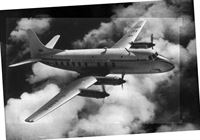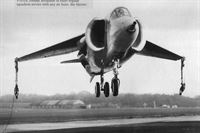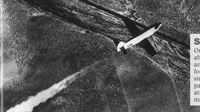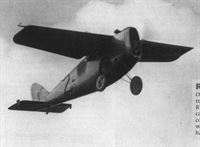Фотографии
-
To the USSR's Ilyushin Il-2/10 Shturmovik ground-attack and anti-tank aircraft goes the credit of being produced in larger numbers than any other single type of aeroplane in history. Throughout most of the Second World War, output averaged 1,200 per month, and more than 35,952 Il-2s were built, plus 4,540 examples of its developed version, the Il-10, bringing the grand total to at least 40,492 aircraft.
Самолёты на фотографии: Ильюшин Ил-2М - Россия - 1942
-
Регистрационный номер: F-WTSS At Toulouse, France, on March 2, 1969, Andre Turcat, Aerospatiale's director of flight testing, took the first Concorde prototype, 001/F-WTSS, on its maiden flight, inaugurating the age of supersonic commercial transport. Although its operational career was to be bedevilled by environmental problems, Concorde has remained the world's only successful SST, and 30 years later it is still an inspirational sight in the air.
Самолёты на фотографии: SNIAC, BAC Concorde - International - 1969
-
Регистрационный номер: G-ALVG, G-5-1 The de Havilland D.H.106 Comet entered the record books as the world's first turbojet-powered commercial airliner. Rolled out in April 1949, the first prototype G-5-1/G-ALVG first flew on July 27, 1949, under the power of four 4,450lb-thrust de Havilland Ghost 50s. The first production aircraft flew on January 1, 1950, and British Overseas Airways Corporation began regular operations on May 2, 1952.
Самолёты на фотографии: De Havilland Comet / D.H.106 - Великобритания - 1949
-
Although no major structural or aerodynamic breakthroughs were required to create the Boeing 747, its operating economics truly brought subsonic jet air transport within the reach of many millions of people. The first of the breed, with four Pratt & Whitney JT9-D engines, was rolled out of the company's new Everett factory on September 30, 1968, and took to the air for the first time on February 9 the following year.
Самолёты на фотографии: Boeing Boeing 747 - США - 1969
-
17 декабря 1903 года Орвилл выполнил полет продолжительностью 12 секунд, который стал одним из важнейших событий в истории человечества.
No compilation of the great landmarks in aviation history would be complete without this, the most famous photograph of them all. Taken by John T. Daniels, a resident of Kitty Hawk, North Carolina, using Orville Wright's camera, at 10.35 a.m. on December 17, 1903, it depicts Orville Wright making the brothers' first sustained and controlled flight from the level in their first Flyer, into a 27 m.p.h. wind. Although this flight covered only 120ft and lasted only 12sec, the fourth and final flight that day, made by Wilbur at noon, covered 852ft and lasted 59sec. That might not sound very long, but just count 59 seconds and imagine that first Flyer remaining in the air for that length of time.Самолёты на фотографии: Wright Flyer - США - 1903
-
15 мая 1941г.: через семь лет после начала разработки взлетел экспериментальный самолет Gloster E.28/39, оснащенный ТРД Whittle. Несмотря на скептицизм ВВС, Фрэнку Уиттлу удалось довести конструкцию своего реактивного двигателя.
An early photo of the E.28/39 taken in 1941 before the addition of vertical tailplane fins and jettisonable hood. A second E.28/39 was built, W4046, but was lost in a crash on July 30, 1943.
The world's first purely turbine-powered aeroplane to fly was the Heinkel He 178, which took to the air under the power of its Heinkel-Hirth HeS 3B centrifugal turbojet engine on August 24, 1939. Britain's first turbojet-powered aeroplane, the Gloster E.28/39, made its maiden flight on May 15, 1941, under the power of an 850lb-thrust Whittle W.1 centrifugal turbojet engine. It attained a speed of 300 m.p.h. and an altitude of 25,000ft during 10hr flying with this engine, which was later replaced by an 860lb-thrust W.1A and then a 1,700lb-thrust Power Jets W.2/500.Самолёты на фотографии: Gloster Pioneer / G.40 - Великобритания - 1941
-
Регистрационный номер: G-AHRF, VX211 The first Vickers Viscount, G-AHRF, first flown on July 16, 1948, with Bryce acting as second pilot to "Mutt" Summers.
The first commercial turboprop-powered aircraft to fly was the Vickers Type 630 Viscount, G-AHRF/VX211, which took to the air for the first time on July 16, 1948. Designed as a medium-range airliner to meet the Brabazon IIB Specification, it was originally named Viceroy. It was powered by four 1,125 e.h.p. Rolls-Royce Dart 502 turboprops.Самолёты на фотографии: Vickers Viscount - Великобритания - 1948
-
A significant landmark in turbojet-powered vertical take-off aeroplanes came at Hawker's Dunsfold airfield, Surrey, on October 21, 1960, when the first prototype P.1127, XP831, powered by the unique 10,600lb-thrust Rolls-Royce Pegasus 2 vectored-thrust engine, made its first tentative tethered hover, piloted by Bill Bedford. The first free hovering flight followed on November 19. It heralded the advent of the first V/STOL combat aeroplane to enter regular squadron service with any air force, the Harrier.
Самолёты на фотографии: Hawker P.1127 Kestrel - Великобритания - 1960
-
October 14, 1947, the Bell X-1 Glamorous Glennis, named after the wife of its pilot, Capt Charles E. "Chuck" Yeager, and powered by a Reaction Motors XLR-11-RM5 comprising four separate 1,500lb-thrust rockets which could be fired singly or in unison, was air-launched from its Boeing B-29 parent craft at 20,000ft. After climbing to 40,000ft the X-1 attained a speed of Mach 1-06, and thus became the first manned aircraft to exceed the speed of sound.
Самолёты на фотографии: Bell X-1 - США - 1946
-
There is insufficient space io list all of the incredible records notched up by North American X-15s during the type's test programme, which began in 1959 and ended in November 1968, after 199 flights had been made. Suffice it to say that they were the fastest, highest-climbing aircraft ever built, the highest recorded speed being Mach 6-72 (4,534 m.p.h.) by Maj Pete Knight USAF on October 3, 1967, and the greatest altitude reached being 354,200ft on August 22, 1963. Powered by a 57,000lb-thrust Thiokol (Reaction Motors) XLR99-RM-2 single-barrel rocket motor, the X-15s were air-launched from a Boeing B-52 bomber.
Самолёты на фотографии: North American X-15 - США - 1959
-
Регистрационный номер: NX19903 The commercial counterpart of the Boeing B-17 bomber was the Model 307 Stratoliner, the world's first airliner with a pressurised passenger cabin, which first flew on December 31, 1938. Nine more were built, and the Stratoliner operated its first commercial service, with TWA, in April 1940, though Pan American had received its aircraft first. The pressure differential was 214lb/ft2, equivalent to a cabin altitude of 8,000ft, and the 307 had a ceiling of 26,200ft.
Самолёты на фотографии: Boeing Boeing 307 Stratoliner - США - 1938
-
Регистрационный номер: NC14946 Lockheed's handsome Model 10 Electra was one of several advanced monoplane transports to come from the USA in the mid-1950s and put the European aircraft industry to shame with their advanced features. Its all-metal structure included a monocoque fuselage, retractable undercarriage and variable-pitch propellers.
Самолёты на фотографии: Lockheed Electra 10 - США - 1934
-
Регистрационный номер: WG774 The elegant Fairey Della 2 became the first aeroplane to push the world air speed record beyond 1,000 m.p.h. on March 10, 1956, when it attained 1,131-76 m.p.h. off the English coast at Chichester, Sussex, beating the previous record by nearly 310 m.p.h. Its pilot was Lt Peter Twiss. His record was beaten on December 12 the following year, when a McDonnell F-101A Voodoo reached 1,208 m.p.h.
Самолёты на фотографии: Fairey FD.2 - Великобритания - 1954
-
One of the earliest aeroplanes to feature a retractable undercarriage was the Dayton-Wright RB racer of 1920, which was also a variable-camber cantilever monoplane with an enclosed cockpit, the wing comprising a balsa core skinned with plywood. The retraction mechanism was hand-cranked, and the process took 12 to 20sec.
Самолёты на фотографии: Dayton-Wright RB-1 / Dayton-Wright Racer - США - 1920
Статьи
- -
- A picture of '99 Winners /Photo competition winners/
- Arado Ar 79B D-EMVT /Preservation Profile/
- Millenium moments /Unforgettable events/
- Skywriters /Readers' letters/
- A.Sephton - Getting to know Lizzie /Pilot report/
- D.Taylor - The Setting of the Sun /First-hand history/
- G.Auliard - Old Dutch /Rare bird/
- G.Sands - Flying witness /First-hand history/
- G.Sands, A.Brown - Wycombe warriors /Warbird air-to-air/
- J.Stroud - A million miles flown /A lifetime of flying/
- M.Hooks - Ben Gunn 1929-1999 /Obituary/
- M.Oakey, T.Harmsworth - News
- P.Cooper - A revival for the Factory? The Farnborough F.1 /Farnborough past & future/
- P.Jarrett - Historic colour. Westland Lysander /Pre-WW2 colour photography/
- P.Jarrett - Landmarks in the sky /Epoch-making aircraft/
- P.McDonnell - Requiem for the Rotodyne /Type history/
- R.Beamont - Command Performance. Exporting the Canberra /First-hand history/
- T.Gwynn-Jones - Tokyo Express /Long-distance flights/
- T.Harmsworth - The future of the past /Preservation in the 21st century/













